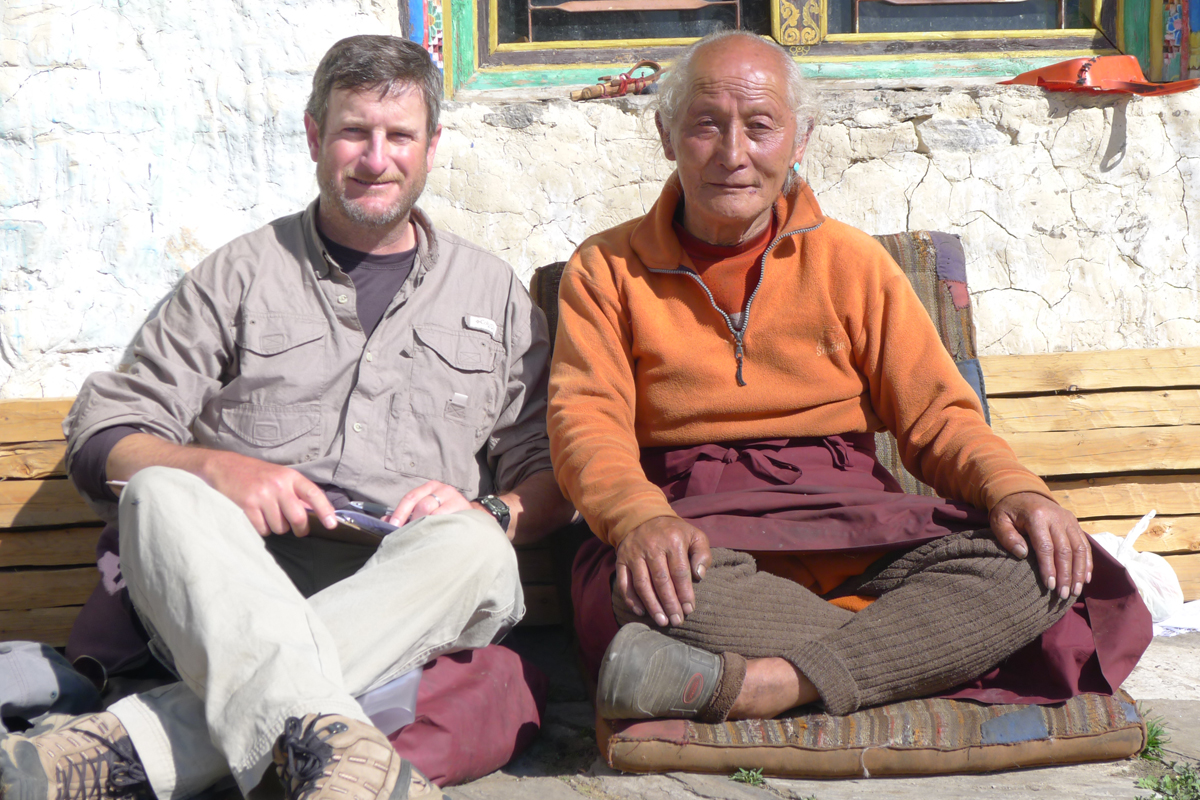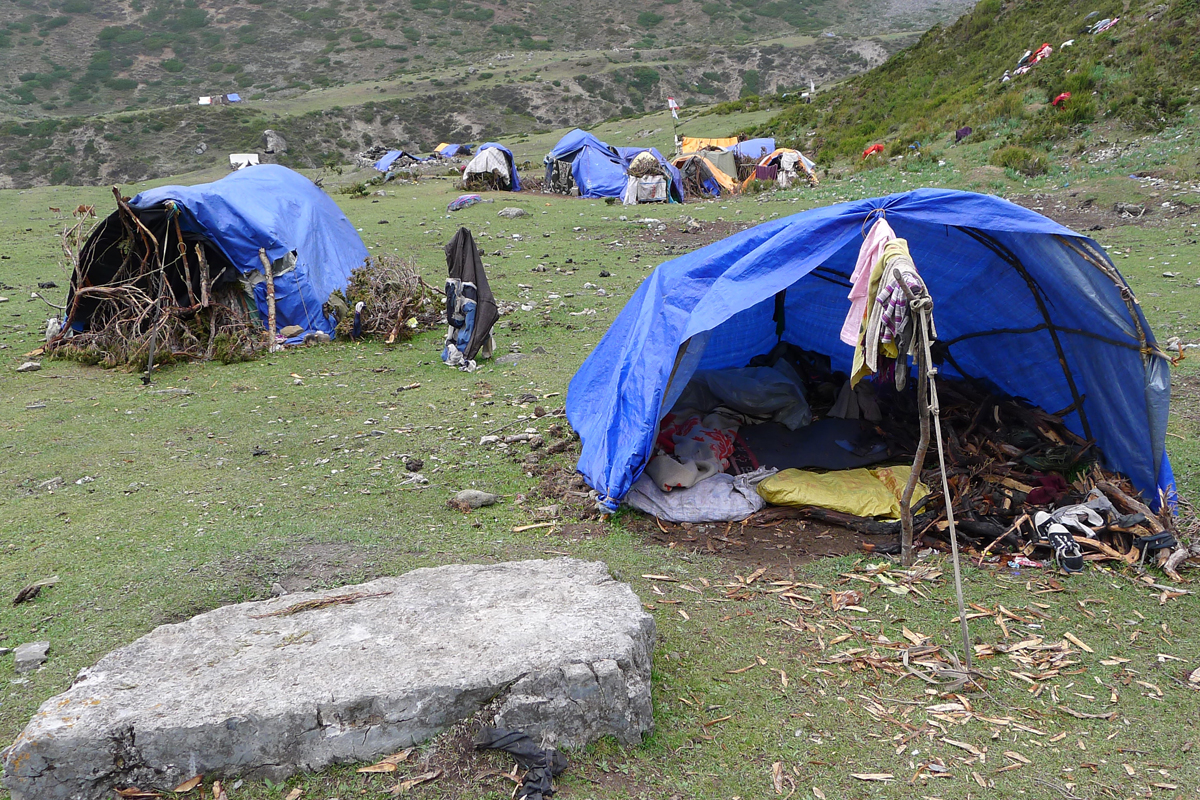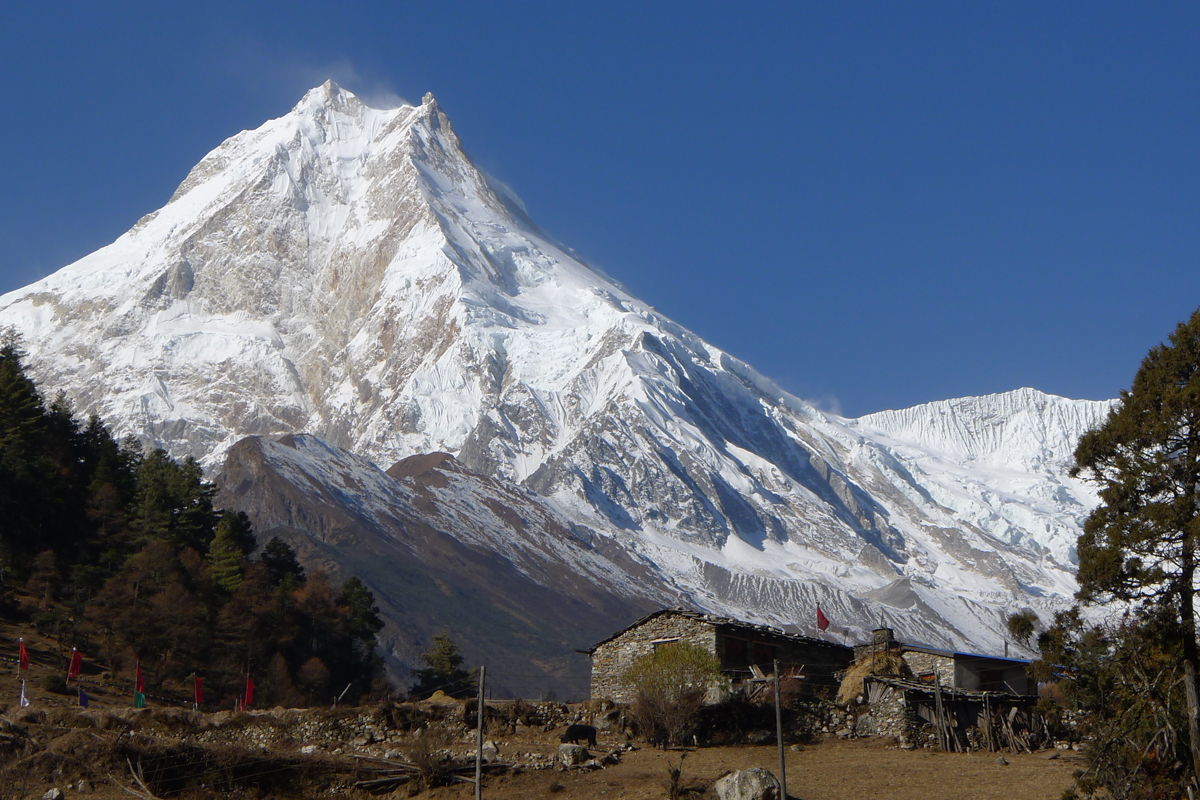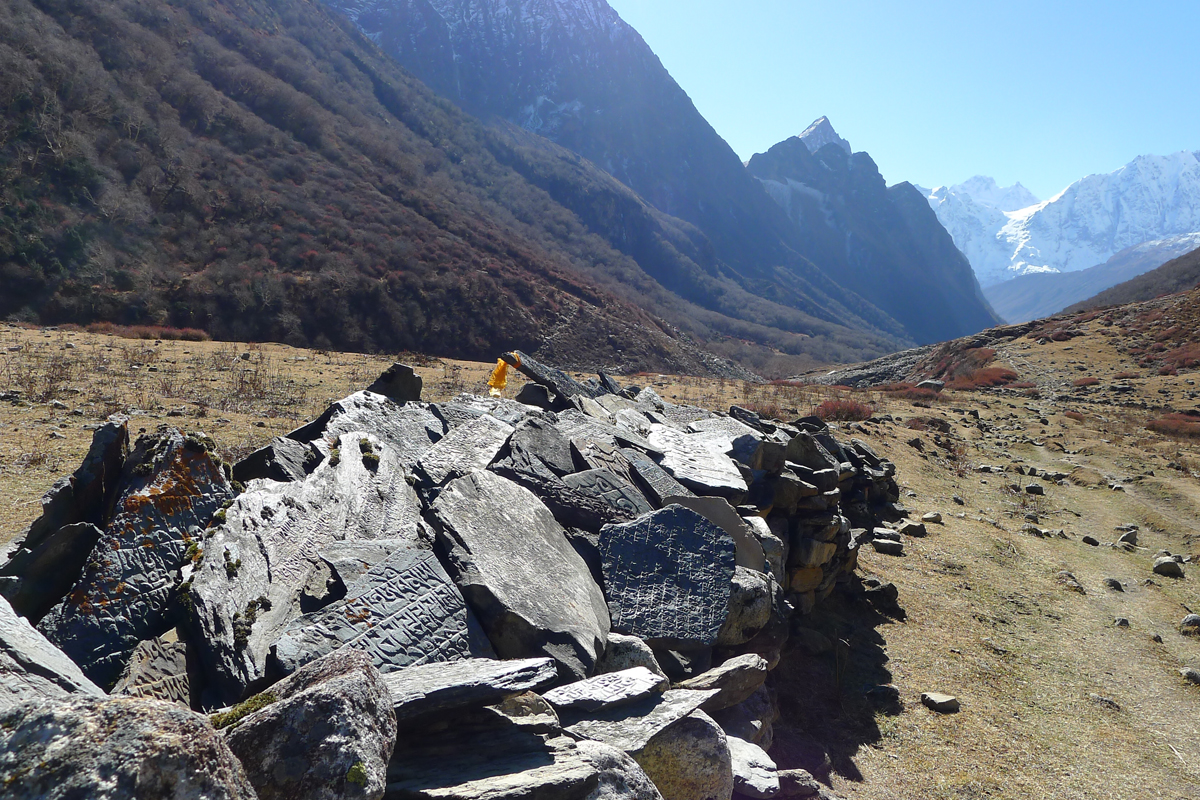Harvesting "Himalayan Viagra"
Air Date: Week of November 14, 2014

Cleaning harvested yartsa gunbu prior to sale. (Photo: Courtesy of Geoff Childs)
A Tibetan fungus is being sold on the Chinese medicine market as an aphrodisiac, bringing income and problems to rural villages on the Tibetan plateau. Anthropologist Geoff Childs of Washington University tells host Steve Curwood how one village is managing to harvest the resource sustainably.
Transcript
CURWOOD: Among the many resources of Tibet is a fungus that Chinese medicine prizes as an aphrodisiac. It’s been the target of collectors and speculators, and the source of conflicts and even some deaths up in the fragile Himalayan grasslands. But one community in the highlands of Nepal has found a way to manage the harvest sustainably using cultural traditions, laws and concensus. Geoff Childs is an anthropologist at Washington University in St. Louis, who wrote in the journal Himalaya about the fungus called yartsa gunbu.

Anthropologist Geoff Childs with Lama Gyatso (Photo: Courtesy of Geoff Childs)
CHILDS: Yartsa Gunbu in Tibetan means “summer grass winter worm”. It's actually a caterpillar of the ghost moth, which becomes infected by a fungus, and in the springtime, the fungus shoots a stoma out of the ground, which allows people to locate it in highland pastures. Generally it grows at 12,000 feet and above, and it's become very popular in Chinese herbal medicine for health, longevity, to boost the immune system. It's considered to be a libido enhancement, which is why some people like to call it the Himalayan Viagra.
CURWOOD: I gather it sells very well.
CHILDS: It's extremely popular in China now to the point where in many rural areas on the Tibetan Plateau, gathering it has become the primary source of income for rural dwellers, so people are basically suspending all other activities in the months of picking which generally come starting in late May and run through June. And the whole family moves up to the high pastures to gather it, so that it can be sold to middlemen who take it to China and that's where the market really takes off.
CURWOOD: So in general how has it been harvested in recent years?
CHILDS: People will basically crawl along the ground looking for it and when they find it they'll carefully dig it out with the spade or some digging implement and remove it from the soil because you want it intact: You want the caterpillar body and the fungal stoma as well. That's where it's got the value. If it's broken apart it doesn't have the same value so they dig it out very carefully and, you know, a good day somebody can maybe find 20 to 30 of these. Some people are adept and can find 100 or more.
CURWOOD: Wow. And each one of these is worth quite a bit.

Yartsa gunbu (Ophiocordyceps sinensis), also known as Himalayan Viagra. (Photo: Courtesy of Geoff Childs)
CHILDS: Yeah. Each one has gotten from middlemen about 500 rupees. If it's really good, maybe 750 rupees. So $5 to $7.50, which, in a place where there is very little income earning opportunities, that's a lot of money.
CURWOOD: What are the environmental impacts of all this harvesting? I mean, all these people running around the hillsides there in the mountainous Himalayas, some of that's pretty fragile stuff.
CHILDS: Yes, that's certainly going to have an impact, and especially in those areas were they allow a lot of people to gather. Number one, you're going to have people chopping down the juniper for fuelwood because they have to cook their food and keep warm, so there's going to be an environmental impact there. There is also a lot more people digging up the turf, which is fragile high-altitude alpine turf, so that we'll certainly have an impact. And then there's the garbage issue. People will bring in goods and set up stores. It's not just the harvesters that are making money, it's people who are catering to their needs who make money, and behind those stores there's often a very large heap of garbage.
CURWOOD: Now, you did much of your research in this small Tibetan area called Nubri and you say that they are doing things differently there. How so?

Rudimentary shelters inhabited by yartsa gunbu collectors. (Photo: Courtesy of Geoff Childs)
CHILDS: Yes, correct. Nubri is a valley in Gurkha district in the country of Nepal. The residents are ethnically Tibetan. They've been living there for about 700 or 800 years, so it's an indigenous population of Nepal. What they have done in contrast to other areas is they've limited the number of collectors to only residents of the villages, and so that keeps the number of collectors way down.
CURWOOD: Tell me how the community of Nubri got its regulations put in place.
CHILDS: What they've arrived at in Nubri is a combination of what they call “yultim” which we could translate as village regulations, secular regulations, and “chutim” which are religious regulations. On the religious side, there's a long tradition of protecting the landscape through these ceiling decrees. It's called a “shukya”. What they will do is, they will decree certain areas off-limits to human exploitation, and usually that's a sacred grove of trees, a certain slope of a mountain that a deity inhabits or something like that. So some areas are totally off grounds for gathering because they have been decreed a religious protected area. In terms of the sustainability of Yartsa Gunbu, that's going to be important because those are areas where annually nobody will harvest it. So it can come to fruition. It can spore. It can live out its normal life cycle.
In terms of the village regulations the first one that I just mentioned is the exclusion of all outsiders. The second one is they've got a designated starting date, and they arrive at that by looking at the snow melt, looking at the conditions in the alpine pasture and figuring out what's going to be the likely time when it's best to gather it. And so for a couple weeks prior to the official starting date, every adult in the village has to check in four times daily to the village meetinghouse to prove that you're not collecting early. A third thing that they do is they tax it. For the first member of your household, the tax is very low; it's 100 rupees or approximately $1 dollar. For every additional household member, it's 4,500 rupees, so about $50 dollars and they gather that tax and use it for communal purposes.
CURWOOD: So this consensus process, everybody agrees, everybody trusts, but they also verify.

Mt. Manaslu (26,759ft.) in Nubri is the 8th highest mountain in the world. (Photo: Courtesy of Geoff Childs)
CHILDS: Exactly. It's a very transparent system, but it is also regulated in such a way that you need to show up. Everybody takes it very seriously.
CURWOOD: So, how has Yartsa Gunbu harvest changed the economics of Nubri?
CHILDS: It's changed it tremendously. There's positives and there's negatives. The positives are people suddenly have money that they can use for their children's education; a lot of people are using it to send their children to boarding schools. They can improve their housing. I've seen a lot of improvements in local housing, upgrading the conditions of their housing. They can buy food with it. They don't produce enough food locally; they’ve had to trade various products in the past to get enough food. Now they've got cash to purchase food. On the negative side, you can imagine that people who have never had this type of income, when they suddenly come into money, it can cause a lot of social problems, so gambling and drinking are way up. There's also friction within families. Younger members tend to take the income and go to the city and blow it all really quickly, whereas the older members want to conserve it and use it in a way that benefits the family. So it has certainly improved their livelihood and their standard of living, but of course it does come at a cost.

Prayers inscribed on stones mark the trail to the high pastures where people collect yartsa gunbu. (Photo: Courtesy of Geoff Childs)
CURWOOD: So Jeff, looking at this from a broader resource management perspective, what are some lessons that we can take away from what's happening in Nubri?
CHILDS: Trust indigenous people. Don't immediately assume that as outsiders with more education we can come in and devise a system that will work for them. I think, first of all, study what's in place. Study with an open mind and move from there.
CURWOOD: Jeff Childs is an Anthropology Professor at Washington University in St. Louis. Thanks so much for taking the time with me today Professor.
CHILDS: Thank you for talking with me. It's been a pleasure, Steve.
Links
Anthropologist Geoff Child’s paper on sustainable harvesting and management of Yartsa Gunbu
Geoff Childs is an Associate Professor of Anthropology with Washington University in St. Louis
Living on Earth wants to hear from you!
Living on Earth
62 Calef Highway, Suite 212
Lee, NH 03861
Telephone: 617-287-4121
E-mail: comments@loe.org
Newsletter [Click here]
Donate to Living on Earth!
Living on Earth is an independent media program and relies entirely on contributions from listeners and institutions supporting public service. Please donate now to preserve an independent environmental voice.
NewsletterLiving on Earth offers a weekly delivery of the show's rundown to your mailbox. Sign up for our newsletter today!
 Sailors For The Sea: Be the change you want to sea.
Sailors For The Sea: Be the change you want to sea.
 The Grantham Foundation for the Protection of the Environment: Committed to protecting and improving the health of the global environment.
The Grantham Foundation for the Protection of the Environment: Committed to protecting and improving the health of the global environment.
 Contribute to Living on Earth and receive, as our gift to you, an archival print of one of Mark Seth Lender's extraordinary wildlife photographs. Follow the link to see Mark's current collection of photographs.
Contribute to Living on Earth and receive, as our gift to you, an archival print of one of Mark Seth Lender's extraordinary wildlife photographs. Follow the link to see Mark's current collection of photographs.
 Buy a signed copy of Mark Seth Lender's book Smeagull the Seagull & support Living on Earth
Buy a signed copy of Mark Seth Lender's book Smeagull the Seagull & support Living on Earth

